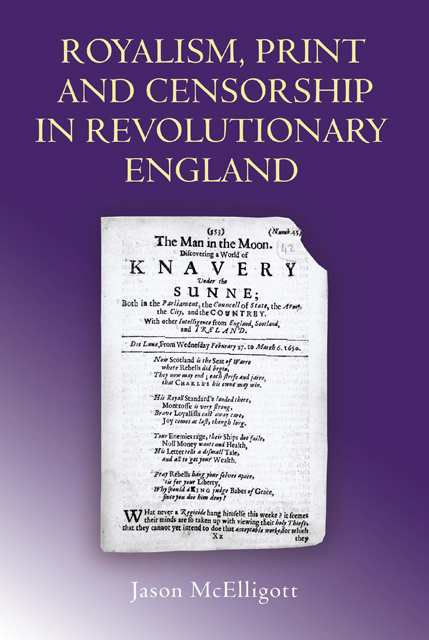Book contents
- Frontmatter
- Contents
- Illustrations
- Acknowledgements
- Abbreviations
- Introduction: Royalism and its Problems
- 1 Royalists and Polemic in the 1640s
- 2 The Politics of Sexual Libel
- 3 The Twists and Turns of Royalist Propaganda
- 4 Authors, Shifting Allegiances and the Nature of Royalism
- 5 Printers, Publishers and the Royalist Underground
- 6 Hunting the Royalist Press
- 7 The Theory and Practice of Censorship
- 8 A New Model of Press Censorship
- Conclusion
- Select Bibliography
- Index
8 - A New Model of Press Censorship
Published online by Cambridge University Press: 10 March 2023
- Frontmatter
- Contents
- Illustrations
- Acknowledgements
- Abbreviations
- Introduction: Royalism and its Problems
- 1 Royalists and Polemic in the 1640s
- 2 The Politics of Sexual Libel
- 3 The Twists and Turns of Royalist Propaganda
- 4 Authors, Shifting Allegiances and the Nature of Royalism
- 5 Printers, Publishers and the Royalist Underground
- 6 Hunting the Royalist Press
- 7 The Theory and Practice of Censorship
- 8 A New Model of Press Censorship
- Conclusion
- Select Bibliography
- Index
Summary
The preceding chapters have described the process by which the authorities in London tracked down and suppressed the royalist press in the late 1640s, and suggested that the currently accepted model for the relationship between government and the press in early-modern England is fatally flawed. Having deconstructed the ‘new orthodoxy’ on censorship this chapter will put forward a number of propositions which go some way towards constructing a new model of how censorship of the press operated in the era of pre-publication licensing. These conclusions are based upon a consideration of the way the Cromwellian regime suppressed the royalist press but they have a broader importance for those interested in the development of print-culture and censorship, because this remarkable feat was achieved using a variety of bodies and mechanisms available to the authorities in the 150 or so years before 1695.
There are four inter-related points. There was an early-modern state and it could enforce its will upon the press when it chose to do so. Censorship is a qualitative rather than a quantitative process. Censorship is also a pragmatic, contingent and grubby process dependent on the actions of individuals, which often defies idealized, abstract notions of how it should operate. Finally, there were a variety of factors which might make censorship of a particular item more or less likely, but it was almost impossible for contemporaries to judge in advance how any or all of these factors would interact with each other. In other words, there was no generally known and accepted code of ‘functional ambiguity’ which enabled authors to encode their opinions so that nobody would be required to make an example of them. Instead, a number of aggravating factors might lead a variety of individuals or organizations to choose to make an example of a particular author or any other member of the book trade connected to the offending item. The book or pamphlet might not necessarily have been subjectively offensive – its author might not have intended it or believed it to have been controversial – but a whole range of factors might conspire to render it objectively provocative.
- Type
- Chapter
- Information
- Royalism, Print and Censorship in Revolutionary England , pp. 210 - 224Publisher: Boydell & BrewerPrint publication year: 2007



